

Disease. Asteroids. Climate Change. Natural Disaster Responce. Networks. Violent Crime and Terrorism. Almost-geddons. Privacy & Identity. Global catastrophic risks. A global catastrophic risk is a hypothetical future event with the potential to inflict serious damage to human well-being on a global scale.[2] Some such events could destroy or cripple modern civilization.
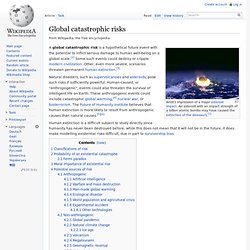
Other, even more severe, scenarios threaten permanent human extinction.[3] Natural disasters, such as supervolcanoes and asteroids, pose such risks if sufficiently powerful. Human-caused, or "anthropogenic", events could also threaten the survival of intelligent life on Earth. These anthropogenic events could include catastrophic global warming,[4] nuclear war, or bioterrorism. The Future of Humanity Institute believes that human extinction is more likely to result from anthropogenic causes than natural causes.[5][6] Human extinction is a difficult subject to study directly since humanity has never been destroyed before; while this does not mean that it will not be in the future, it does make modelling existential risks difficult, due in part to survivorship bias. Fermi paradox[edit] Torino Scale. The Torino Scale is a method for categorizing the impact hazard associated with near-Earth objects (NEOs) such as asteroids and comets.
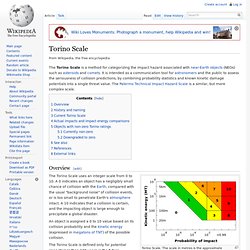
It is intended as a communication tool for astronomers and the public to assess the seriousness of collision predictions, by combining probability statistics and known kinetic damage potentials into a single threat value. The Palermo Technical Impact Hazard Scale is a similar, but more complex scale. Overview[edit] Torino Scale. The scale in metres is the approximate diameter of an asteroid with a typical collision velocity. The Torino Scale uses an integer scale from 0 to 10. An object is assigned a 0 to 10 value based on its collision probability and the kinetic energy (expressed in megatons of TNT) of the possible collision. The Torino Scale is defined only for potential impacts less than 100 years in the future. "For an object with multiple potential collisions on a set of dates, a Torino Scale value should be determined for each date.
See also[edit] The World Is Running Out of an Essential Snakebite Anti-Venom. 10 Reasons Our Shallow Fresh Water Supply is in Deep Trouble. Jeffrey GreenActivist Post Fresh clean water is essential to all life forms.
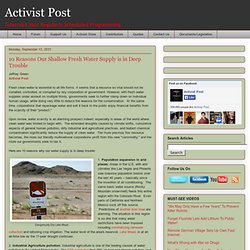
It seems that a resource so vital should not be corralled, controlled, or corrupted by any corporation or government. However, with fresh water supplies under assault on multiple fronts, governments seek to further clamp down on individual human usage, while doing very little to reduce the reasons for the contamination.
At the same time, corporations that repackage water and sell it back to the public enjoy financial benefits from the scarcity of their "product. " Upon review, water scarcity is an alarming prospect indeed; especially in areas of the world where clean water was limited to begin with. Here are 10 reasons why our water supply is in deep trouble: 1. 2. 3. 4. 5. 6. 7. 8. 9. 10. As our public drinking water becomes more limited because of contamination, the purification process applies more chemicals -- which further compromises the quality of water.
Doomsday clock holds steady at five minutes to apocalypse. Honest question: What relevance does the Doomsday Clock have these days?
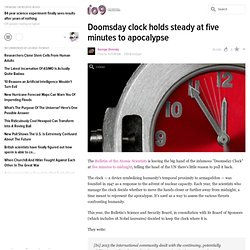
I understand it was a powerful symbol during the Cold War era, and I get the value of having *something* to reflect, however imperfectly, the mood and dangers of the era; but are we really living in a world that is "minutes" from devastation, or does that mindset in a way minimize the long-term threats that we're facing?
The Bulletin now considers climate change, but only as one of a handful of potential threats - war and weaponry (specifically of the nuclear kind) remains the primary focus of the clock. I guess what I'm asking is this: Do we still feel that conflict between major nations is such an imminent threat, or does it make sense at this point to shift to the consequences of inaction? There are a hell of a lot of nukes in the world, land, air and sea and terrorists that would use them on their enemies given a chance. The mere possibility of that scenario should keep the threat level high. Name one. Fukushima nuclear disaster.
No, Iran Is Not An Apocalyptic Nuclear Cult. So let me just put a picture here.
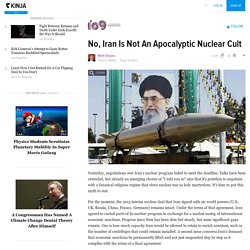
Expand If you look at this image, there's five countries with actual nuclear weapons: Russia (it's light green and unmarked on the image), Turkey (it has nuclear weapons that are the property of the US), Pakistan, India, and Israel. So of the countries bordering Iran, two have nuclear weapons. And there's three countries nearby that also have nuclear weapons.
And, heck, until 1995 and 1996, there were two more nearby countries that had nuclear weapons: Kazakhstan and Ukraine. So Iran doesn't exist in a region that has no nuclear weapons. And we're supposed to be surprised if it's paranoid?